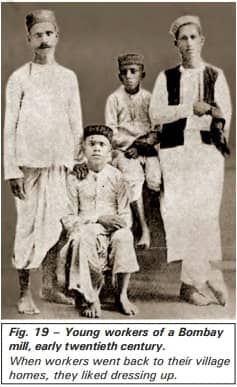NCERT History Class 10 | Factories Come Up – Concept and Notes
Topic & sub-topics covered: Factories Come Up, The Early Entrepreneurs, Where Did the Workers Come From?: The Age of Industrialisation (All single detail notes are exam-oriented).
We have discussed in-depth and exam-oriented pointers that can be asked in the board exam of class 10th about “Factories Come Up, The Early Entrepreneurs, Where Did the Workers Come From?” which is taken from the NCERT History book for class 10th chapter no. 4 The Age of Industrialisation.
Download NCERT History Chapter 4 Class 10th Notes PDF for The Age of Industrialisation
If you are in class 10th and looking for free NCERT History chapter 4 notes of the chapter The Age of Industrialisation class 10 that cover concepts, then you can download the free class 10th History chapter 4 notes “The Age of Industrialisation”. You should download this free PDF for future test or exam preparations.
Factories Come Up
1. Emergence of Cotton Mills:
- The first cotton mill in Bombay was established in 1854, marking the beginning of industrialization in India.
- It commenced production two years later, indicating a rapid shift towards factory-based textile manufacturing.
2. Expansion in Bombay:
- By 1862, Bombay had four mills in operation, equipped with 94,000 spindles and 2,150 looms.
- This growth highlighted the quick expansion and adoption of mechanized production in the textile sector.
3. Jute Mills in Bengal:
- Jute mills emerged in Bengal around the same time, with the first established in 1855 and another in 1862.
- This diversification showcased the spread of industrialization beyond traditional cotton-based textiles.
4. North India’s Entry:
- The Elgin Mill was initiated in Kanpur during the 1860s, marking the industrialization of North India.
- Ahmedabad’s first cotton mill followed suit a year later, contributing to the regional spread of textile industries.
5. Southern Development:
- In 1874, the first spinning and weaving mill in Madras started production, signifying the South’s entry into the industrial landscape.
These developments collectively reflected the early phases of industrialization in different regions of India, particularly in the textile sector.
Question: Who set up the industries? Where did the capital come from? Who came to work in the mills?
Answer: The industries were set up by investors who saw opportunities for investment in industries. The capital came from joint-stock companies that were set up and managed by investors. As colonial control over Indian trade tightened, the space within which Indian merchants could operate became limited, and they turned to the countryside to set up their businesses. Poor peasants and artisans began working for these merchants. The workers in the mills were mostly poor peasants and artisans who migrated from the countryside to the cities in search of work.
The Early Entrepreneurs
1. Diverse Origins of Industrialists:
- Industrialists in India emerged from various backgrounds and regions.
- Trade with China played a significant role in the financial foundation of many business groups.
2. China Trade Influence:
- British opium exports to China and tea imports to England involved Indian participants.
- Entrepreneurs like Dwarkanath Tagore in Bengal and Parsis like Dinshaw Petit and Jamsetjee Nusserwanjee Tata in Bombay accumulated wealth through China trade.
3. Marwari and Other Connections:
- Seth Hukumchand, a Marwari businessman, established the first Indian jute mill in Calcutta in 1917, also involved in trade with China.
- Merchants from Madras had trade connections with Burma, and others operated within India, engaging in internal trade and financing.
4. Challenges under Colonial Rule:
- Indian merchants faced limitations as colonial control tightened.
- Restrictions on trading with Europe in manufactured goods and increased reliance on exporting raw materials impacted their operations.
5. Role of European Managing Agencies:
- European Managing Agencies controlled a significant portion of Indian industries till the First World War.
- Bird Heiglers & Co., Andrew Yule, and Jardine Skinner & Co. were major players in mobilizing capital and managing joint-stock companies.
6. Challenges in Chamber Participation:
- European merchant-industrialists had exclusive chambers of commerce.
- Indian businessmen were excluded from joining these chambers, limiting their influence and participation.
These points highlight the diverse origins of Indian industrialists, their financial roots in trade networks, and the challenges they faced under colonial rule, especially in the context of the China trade and European Managing Agencies.
Where Did the Workers Come From?

1. Factory Worker Growth:
- Significant growth in the number of factory workers over the years: 584,000 in 1901 to over 2,436,000 by 1946.
- The expansion of factories led to an increased demand for labour.
2. Origin of Workers:
- Workers mostly originated from districts surrounding industrial regions.
- Peasants and artisans from villages sought employment in industrial centres.
3. Regional Movement:
- Over 50% of Bombay cotton industry workers in 1911 came from the nearby Ratnagiri district.
- Kanpur mills mainly employed textile workers from within the Kanpur district.
4. Village-City Migration:
- Millworkers frequently moved between villages and cities.
- Return to village homes during harvests and festivals was common.
5. Long-Distance Travel:
- Workers, attracted by employment prospects, traveled great distances for work.
- Example: Workers from the United Provinces went to Bombay for textile jobs and Calcutta for jute mills.
6. Challenges in Employment:
- Job availability was limited; demand exceeded supply.
- Entry into mills was restricted, often facilitated by jobbers.
7. Role of Jobbers:
- Jobbers, typically trusted workers, helped recruit new workers.
- Gained authority and power, demanding money and gifts for their services.
8. Increasing Factory Workforce:
- The number of factory workers increased over time.
- Jobbers played a crucial role in facilitating employment.
9. Proportion of Industrial Workforce:
- Factory workers constituted a small proportion of the overall industrial workforce.
These pointers summarize the growth of the factory workforce, the origin and movement of workers, challenges in employment, the role of jobbers, and the proportion of factory workers in the total industrial workforce.
Next & Previous Topics of NCERT/CBSE History Class 10 Chapter 4: The Age of Industrialisation
FAQ
Q1. What is the meaning of “factories come up”?
Answer: “Factories come up” refers to the establishment and growth of factories, particularly during the Industrial Revolution. This term signifies the emergence of industrial production and the transition from manual to mechanized manufacturing processes, leading to significant economic and social changes. The phrase is often used in the context of the historical development of industrialization, highlighting the expansion of factory-based production and its impact on various regions, including the colonies.
Q2. What are the economic implications of “factories come up”?
Answer: The economic implications of “factories come up” during the Industrial Revolution were significant. The rise of factories led to increased productivity, efficiency, and economies of scale, which in turn contributed to the growth of industries and the expansion of international trade. The development of factories facilitated the mechanization of production processes, allowing for the mass production of consumer goods at a lower cost. This led to the emergence of new industries, such as cotton textiles and iron and steel production, which contributed to the growth of the economy. Additionally, the establishment of factories led to the creation of new jobs, providing employment opportunities for the local population and contributing to the growth of the economy.

